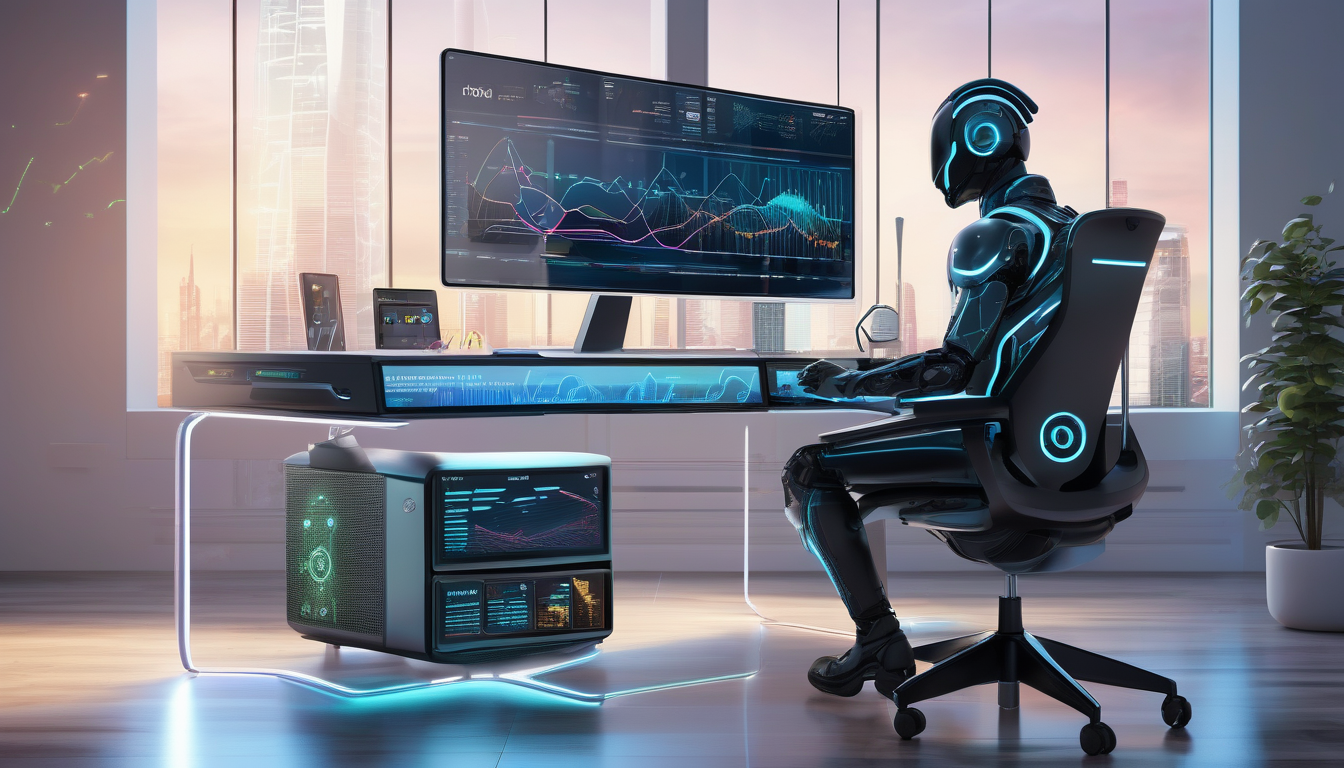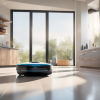AI-Powered Personal Assistants: The Next Evolution

In today’s fast-paced world, AI-powered personal assistants have emerged as indispensable tools that enhance our daily lives. These digital companions have evolved remarkably, transitioning from simple voice commands to sophisticated systems that can understand context, learn from user interactions, and offer personalized assistance. Imagine having a virtual assistant that not only schedules your meetings but also knows your preferences and suggests the best times to meet based on your past behavior. This is not science fiction; it’s the reality we live in today!
The journey of AI personal assistants began with basic functionalities, but with rapid technological advancements, they have become smarter and more intuitive. The growing demand for these virtual helpers is evident in various sectors, from healthcare to finance, where they streamline processes and improve efficiency. As we delve deeper into the transformative role of these assistants, it becomes clear that their integration into our lives is not just a trend but a significant evolution in how we interact with technology.
As we explore the key features of AI assistants, we will uncover the magic behind their capabilities. For instance, natural language processing allows these assistants to understand and respond to human language in a way that feels natural and engaging. Coupled with advancements in voice recognition technology, users can now issue commands and receive responses almost as if they were conversing with another person. This seamless interaction enhances user engagement and makes technology more accessible to everyone.
Moreover, the importance of contextual understanding cannot be overstated. AI assistants are designed to remember user preferences and previous interactions, which helps them provide relevant responses tailored to individual needs. This level of personalization is what sets AI assistants apart from traditional tools and makes them truly revolutionary.
In summary, the evolution of AI-powered personal assistants represents a significant leap in technology that not only simplifies our daily tasks but also enriches our interactions with the digital world. As we continue to embrace these innovations, the question remains: how will these intelligent companions shape our future? The possibilities are endless!

The Rise of AI Personal Assistants
In the past decade, we have witnessed a remarkable transformation in the way we interact with technology, largely due to the emergence of AI personal assistants. These virtual helpers have evolved from simple voice-activated tools to sophisticated systems capable of understanding and anticipating our needs. The journey began with early innovations like Siri and Google Assistant, which laid the groundwork for what was to come. As technology advanced, so did the capabilities of these assistants, fueled by the growing demand for smarter, more efficient solutions in our daily lives.
One of the pivotal moments in this evolution was the integration of machine learning and natural language processing. These technologies enabled AI assistants to not only comprehend spoken commands but also learn from user interactions over time. Imagine having a personal assistant that gets better at understanding your preferences with every conversation; that’s the power of machine learning at work. Today, AI assistants can manage everything from your calendar to your smart home devices, creating a seamless user experience.
Moreover, the rise of AI personal assistants is closely linked to the increasing prevalence of smartphones and smart home devices. According to a recent survey, over 50% of households in the U.S. now utilize smart assistants in some form. This statistic highlights a significant shift in consumer behavior, as people seek out technology that simplifies their lives. Here’s a quick look at the factors driving this trend:
- Convenience: AI assistants streamline daily tasks, making it easier to manage appointments and reminders.
- Efficiency: With the ability to automate routine activities, users can focus on more critical aspects of their lives.
- Integration: These assistants work harmoniously with various devices, enhancing the overall user experience.
As we look to the future, the rise of AI personal assistants is just the beginning. With ongoing advancements in technology, we can expect these virtual companions to become even more integrated into our lives, transforming not only how we interact with our devices but also how we approach tasks in our everyday routines. The possibilities are endless, and the journey is just getting started!

Key Features of AI Assistants
AI personal assistants are not just fancy gadgets; they are revolutionizing how we interact with technology every day. At their core, these intelligent systems are designed to make our lives easier, and they come packed with essential functionalities that set them apart from traditional tools. From understanding our commands to learning from our habits, these features are what make AI assistants indispensable in our fast-paced world.
One of the standout characteristics of AI assistants is their natural language processing (NLP) capability. Imagine having a conversation with a friend who understands you perfectly—this is what NLP aims to achieve. It allows AI assistants to comprehend and respond to human language in a way that feels natural and intuitive. This means you can ask your assistant a question as you would a person, and it will understand your intent and provide relevant answers.
With advancements in NLP, AI assistants can now handle complex queries and provide contextually relevant responses. For instance, if you ask, “What’s the weather like today?” the assistant not only understands the question but also knows to give you a weather update based on your location. This level of interaction is what makes using AI assistants so engaging.
Another key feature is voice recognition technology. This technology has come a long way, allowing AI assistants to accurately interpret spoken commands. Gone are the days of frustrating misinterpretations; now, you can simply speak your command, and your assistant will follow through. This hands-free capability is particularly useful when you’re busy, making multitasking a breeze.
Moreover, AI assistants excel in contextual understanding. They don’t just respond to isolated commands; they remember your preferences and past interactions. For example, if you frequently ask for coffee shop recommendations, your assistant will prioritize those types of suggestions in the future. This personalized touch enhances user experience and builds a more meaningful connection between you and your assistant.
Last but not least, the integration of machine learning algorithms allows AI assistants to continually improve over time. They learn from your behavior, adapting to your preferences and becoming more efficient at completing tasks. This self-improving nature ensures that as you evolve, so does your assistant, keeping it relevant and helpful.
In summary, the key features of AI personal assistants—natural language processing, voice recognition, contextual understanding, and machine learning—work together to create a seamless and efficient user experience. With these capabilities, AI assistants are not just tools; they are becoming essential partners in our daily lives.
Natural Language Processing
Natural Language Processing (NLP) is a fascinating field that serves as the backbone of AI personal assistants. Imagine having a conversation with a friend who not only listens but also understands the nuances of your speech. That’s precisely what NLP aims to achieve! By allowing machines to interpret and respond to human language in a way that feels natural, NLP transforms our interactions with technology into something more intuitive and engaging.
At its core, NLP combines linguistics, computer science, and artificial intelligence to enable machines to understand, interpret, and generate human language. This technology empowers AI assistants to perform a variety of tasks, such as answering questions, providing recommendations, and even engaging in casual conversation. The magic of NLP lies in its ability to break down language into components that machines can comprehend, including grammar, context, and sentiment.
Here are some key components that make NLP so effective:
- Tokenization: This process involves breaking down text into smaller units, or tokens, which can be words or phrases. It helps AI understand the structure of sentences.
- Syntactic Analysis: This refers to the grammatical analysis of sentences. It helps the AI grasp relationships between words, allowing for more accurate responses.
- Semantic Analysis: This goes a step further by interpreting the meanings of words and phrases in context, enhancing the assistant’s ability to provide relevant answers.
Furthermore, the advancements in NLP have paved the way for voice recognition technology, which allows AI assistants to accurately interpret spoken commands. This is crucial, as many users prefer speaking to typing. Imagine asking your assistant to set a reminder just by saying it out loud! This seamless interaction enhances user engagement and makes technology feel less intimidating.
Contextual understanding is another vital aspect of NLP. By analyzing previous interactions and user preferences, AI assistants can tailor their responses to be more relevant and personalized. For example, if you frequently ask about the weather, your assistant might proactively provide updates without you even having to ask. This level of personalization not only improves user experience but also builds a sense of trust and reliability in the technology.
In summary, Natural Language Processing is a game-changer in the world of AI personal assistants. It not only makes interactions smoother and more human-like but also sets the stage for a future where technology understands us better than ever before.
Voice Recognition Technology
Voice recognition technology is nothing short of a game changer in the realm of AI personal assistants. Imagine waking up in the morning and simply saying, “Good morning!” to your assistant, and it responds with the weather forecast, your schedule for the day, and even a motivational quote to kickstart your morning. This seamless interaction is made possible through sophisticated algorithms that analyze and interpret spoken language.
At the heart of this technology lies machine learning, which allows AI assistants to improve their understanding of human speech over time. Initially, voice recognition systems struggled with accents, dialects, and background noise, often leading to frustrating user experiences. However, with continuous advancements, these systems have become increasingly adept at recognizing diverse voices and commands. Today, they can distinguish between different speakers, making interactions more personalized and effective.
One of the most fascinating aspects of voice recognition is its ability to adapt to individual users. For instance, if you frequently ask your assistant to play a specific playlist, it learns your preference and makes it easier for you to access it in the future. This contextual awareness not only enhances the user experience but also fosters a sense of companionship, as the assistant seems to “know” you better with each interaction.
Moreover, the integration of voice recognition technology into smart home devices has revolutionized how we interact with our living spaces. You can simply say, “Turn off the living room lights,” and your assistant will execute the command without you having to lift a finger. This hands-free convenience is a significant advantage, especially for those juggling multiple tasks or for individuals with mobility challenges.
As we look to the future, the potential for voice recognition technology is vast. With ongoing improvements in natural language processing and machine learning, we can expect AI personal assistants to become even more intuitive, understanding not just commands but also the emotions and intentions behind them. This evolution could lead to a world where our virtual helpers are not just tools, but true partners in our daily lives.
Contextual Understanding
In the realm of AI-powered personal assistants, is a game changer. Imagine chatting with a friend who remembers your favorite coffee order or knows your schedule like the back of their hand. That’s the kind of intuitive interaction we expect from our virtual helpers. Contextual understanding allows these AI systems to interpret user queries not just based on the words spoken but also considering the context surrounding those words. This means they can provide more relevant and personalized responses, enhancing the overall user experience.
For instance, if you ask your AI assistant about the weather, it should not only provide the current temperature but also take into account your location and even your upcoming plans. If you have a meeting scheduled outdoors, the assistant might suggest bringing an umbrella if rain is expected. This level of understanding transforms mundane interactions into meaningful conversations.
Moreover, contextual understanding relies heavily on data from previous interactions. The more you engage with your AI assistant, the better it becomes at predicting your needs. It’s like having a personal assistant who learns your preferences over time. Here are some key aspects that contribute to contextual understanding:
- User History: The assistant remembers past queries and preferences, tailoring responses accordingly.
- Real-Time Context: It analyzes current conditions, such as location and time, to provide timely information.
- Emotional Intelligence: Advanced AI can even gauge the emotional tone of your requests, adjusting its responses to suit your mood.
In summary, contextual understanding is what makes AI personal assistants feel less like machines and more like companions. By interpreting the nuances of human language and behavior, these systems are not just reactive but proactive, anticipating our needs and making our lives easier. As technology continues to evolve, we can expect even greater advancements in how these assistants interpret context, leading to a future where interactions are seamless and genuinely helpful.
Machine Learning in Personal Assistants
Machine learning is the secret sauce that makes AI personal assistants not just smart but also incredibly intuitive. Imagine having a virtual assistant that learns your preferences over time, adapting to your unique style and needs. This isn’t just a futuristic dream; it’s happening right now! With machine learning algorithms, these assistants analyze vast amounts of data to improve their performance continuously.
At the core of this technology lies the ability to process and learn from user interactions. Every time you ask your assistant to set a reminder or play your favorite song, it takes note of your preferences. Over time, it begins to predict what you might want before you even ask. For instance, if you frequently request coffee shop recommendations in the morning, your assistant might start suggesting nearby cafes as soon as you wake up. It’s like having a personal concierge who knows your habits inside and out!
The impact of machine learning in personal assistants can be broken down into several key areas:
- Enhanced Personalization: The more you interact with your assistant, the better it understands you. This leads to a more personalized experience, where your assistant can tailor responses and suggestions that resonate with you.
- Improved Accuracy: Machine learning helps refine the accuracy of voice recognition and natural language processing, ensuring that your assistant understands commands correctly, even in noisy environments.
- Predictive Capabilities: By analyzing past interactions, AI assistants can anticipate needs, making them proactive rather than reactive. This means fewer interruptions and a smoother daily routine.
As machine learning technology continues to evolve, we can expect AI personal assistants to become even more sophisticated. They will not only manage our schedules but also understand our moods and preferences, making them invaluable companions in our daily lives. The future of personal assistance is bright, and it’s all thanks to the remarkable advancements in machine learning!

Applications in Daily Life
AI personal assistants have become integral to our daily routines, seamlessly blending technology with our everyday tasks. Imagine waking up to a gentle voice that not only tells you the weather but also reminds you of your appointments for the day. This is just a glimpse of how these digital helpers are transforming our lives. From managing schedules to controlling smart devices, AI assistants are like having a personal concierge at your fingertips.
One of the most exciting aspects of AI personal assistants is their ability to manage schedules and reminders. Gone are the days of sticky notes and alarm clocks. With a simple voice command, you can set reminders for important meetings or even schedule a dinner date. They learn your preferences over time, making suggestions that fit your lifestyle. It’s like having a friend who knows exactly what you need, when you need it!
Moreover, AI assistants are revolutionizing how we interact with our homes. Smart home integration allows these assistants to control everything from lighting to thermostats with just a few words. Imagine walking into your house and saying, “Turn on the lights,” and voilà! The room illuminates, creating the perfect ambiance. This capability not only enhances convenience but also contributes to energy efficiency, allowing users to monitor and control their energy consumption effortlessly.
Additionally, productivity enhancement is another key application of AI personal assistants. They can automate routine tasks, such as managing emails, setting calendar events, and even providing timely updates on tasks that need your attention. This automation frees up time for users to focus on more important activities. Picture this: instead of sifting through countless emails, your assistant can summarize the key points, letting you respond swiftly and efficiently. It’s like having a personal secretary who never tires!
In summary, the applications of AI personal assistants in daily life are vast and varied. They not only enhance our productivity and simplify our routines but also make our homes smarter and more efficient. As technology continues to evolve, the potential of these assistants will only expand, bringing even more surprises and conveniences into our lives.
Smart Home Integration
Imagine walking into your home and having the lights turn on automatically, your favorite music playing softly in the background, and the thermostat adjusting to your preferred temperature—all without lifting a finger. This is the magic of AI-powered personal assistants seamlessly integrating into our smart home ecosystems. With advanced technology at their core, these assistants are not just tools; they are becoming essential partners in creating a comfortable and efficient living environment.
The integration of AI personal assistants into smart homes is revolutionizing how we interact with our living spaces. These assistants can control a range of devices, from lights and thermostats to security cameras and kitchen appliances. The beauty lies in their ability to learn your habits and preferences, allowing them to automate tasks that once required manual effort. For instance, you might set your assistant to dim the lights and play soothing music at a specific time each evening, creating the perfect ambiance for relaxation.
Moreover, the connectivity of smart home devices is enhanced through the use of protocols such as Wi-Fi, Bluetooth, and Zigbee. This means that whether you’re at home or away, you can monitor and control your devices remotely. Imagine being at work and receiving a notification that your front door has been left unlocked. With just a tap on your smartphone, you can lock it from anywhere, ensuring your home remains secure.
Here’s a quick look at some of the remarkable functionalities of AI personal assistants in smart home integration:
- Voice Commands: Control devices using simple voice commands, making hands-free operation a breeze.
- Routine Automation: Set up routines that trigger multiple actions with a single command, like “Goodnight” to turn off lights and lock doors.
- Energy Management: Optimize energy usage by scheduling devices to run during off-peak hours, saving you money on utility bills.
As we move forward, the future of smart home integration with AI personal assistants looks incredibly promising. With ongoing advancements in technology, we can expect even more intuitive features, enhanced security measures, and a deeper understanding of our needs. It’s not just about convenience; it’s about creating a personalized living experience that adapts to us, making our homes smarter and our lives easier.
Productivity Enhancement
In today’s fast-paced world, where every second counts, AI-powered personal assistants have emerged as invaluable tools for enhancing productivity. Imagine having a digital sidekick that not only remembers your appointments but also nudges you to stay on track. These smart assistants are designed to streamline our daily tasks, making it easier than ever to juggle work, family, and personal commitments.
One of the standout features of AI assistants is their ability to automate routine tasks. For instance, instead of manually sifting through emails or setting reminders, you can simply ask your assistant to handle it for you. This not only saves time but also reduces the cognitive load, allowing you to focus on more important projects. Think of it as having a personal secretary who never sleeps and is always ready to help!
Moreover, AI assistants excel in managing schedules and providing timely updates. They can analyze your calendar, suggest optimal times for meetings, and even send out invites. This level of organization is crucial for maintaining productivity, especially when juggling multiple responsibilities. For example, you might have:
- Meetings scheduled back-to-back
- Project deadlines looming
- Family commitments to remember
With an AI assistant, you can rest assured that nothing will slip through the cracks. They are designed to learn from your habits and preferences, adapting their suggestions to fit your unique lifestyle. As a result, you can expect a more personalized approach to productivity that evolves with you.
Additionally, the integration of AI assistants with smart home devices amplifies their productivity-enhancing capabilities. Imagine coming home after a long day, and your assistant has already adjusted the lighting, set the thermostat, and even prepared your favorite playlist. This seamless transition from work to home life allows you to unwind without the hassle of manual adjustments.
In conclusion, the impact of AI-powered personal assistants on productivity is profound. They not only help in managing tasks but also create a more organized and efficient environment. As these technologies continue to evolve, we can expect even greater enhancements that will redefine how we approach our daily lives.
Frequently Asked Questions
- What are AI-powered personal assistants?
AI-powered personal assistants are advanced software applications that utilize artificial intelligence to perform tasks and provide services based on user commands. They can manage schedules, control smart home devices, and even answer questions, making them essential tools for enhancing everyday life.
- How do AI personal assistants learn?
These assistants leverage machine learning algorithms to learn from user interactions over time. The more you use them, the better they understand your preferences, making their responses more accurate and personalized.
- Can AI assistants understand natural language?
Absolutely! Thanks to advancements in natural language processing, AI assistants can comprehend and respond to human language in a way that feels natural. This technology allows for more intuitive conversations, making it easier to communicate with your assistant.
- Are AI personal assistants secure?
While AI personal assistants are designed with security features, it’s essential to be cautious. Always review privacy settings and be mindful of the information you share, as data security varies across different platforms.
- What tasks can AI assistants automate?
AI assistants can automate a wide range of tasks, including managing emails, setting reminders, controlling smart home devices, and providing personalized recommendations. This automation can significantly boost your productivity and streamline daily activities.
- How do AI assistants integrate with smart home devices?
AI personal assistants can connect with various smart home devices, allowing you to control everything from lights to thermostats using voice commands or through an app. This integration creates a seamless smart home experience, enhancing convenience and efficiency.













